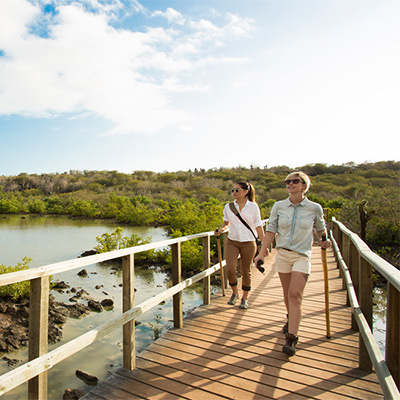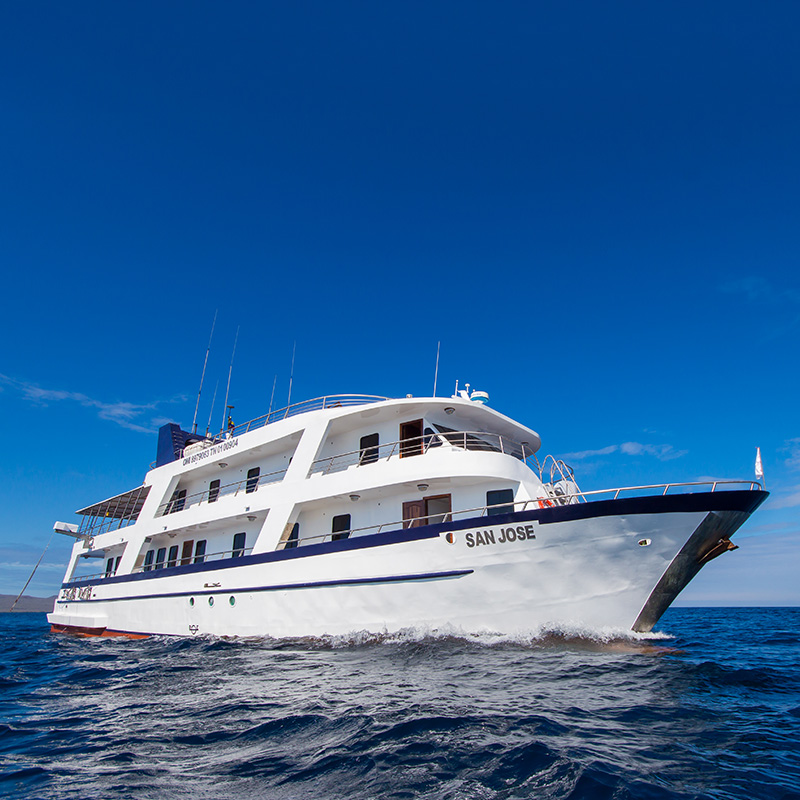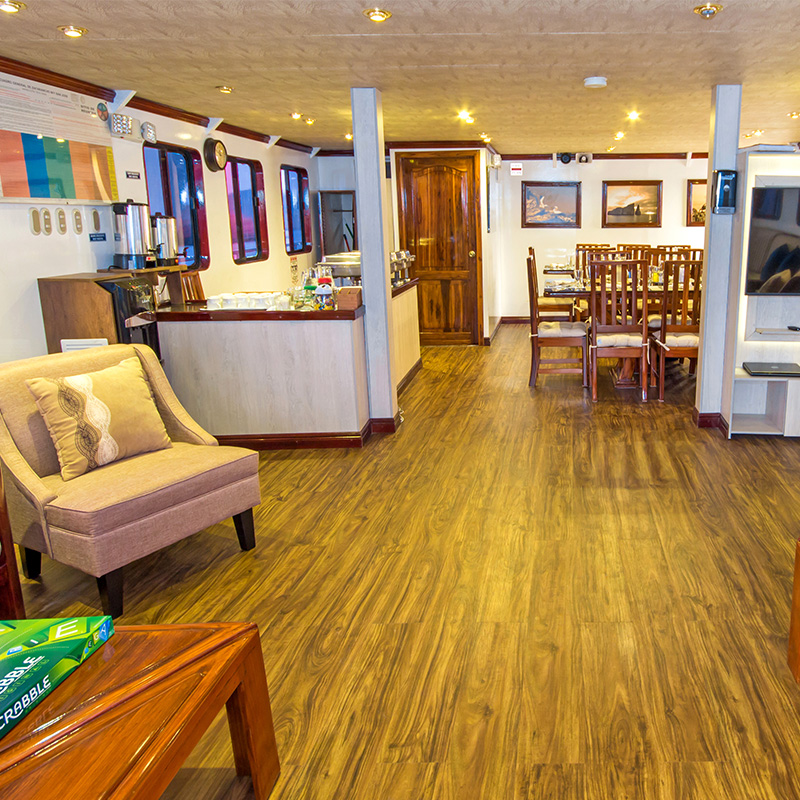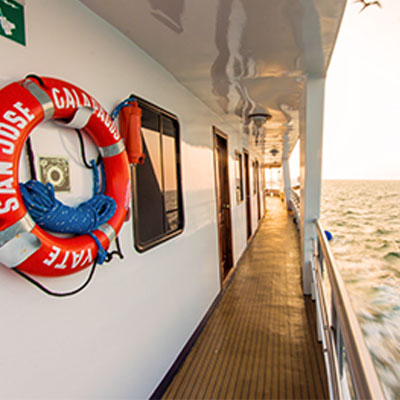GTEG-121 – M/Y GALAPAGOS SAN JOSE – ITINERARY “B”
FOUR DAYS/THREE NIGHTS –TUESDAY TO FRIDAY
Detailed Itinerary
DAY 1: TUESDAY ARRIVAL IN GALAPAGOS ISLAND
Baltra and Mosquera Islet
This morning you arrival at Baltra Airport. In front of the arrival area you will meet your naturalist guide and fellow passengers who will assist you in the shuttle transfer to the Baltra Dock where inflatable dinghies (‘zodiacs’) take you the last stretch to the yacht.
Mosquera lies in the middle of the Itabaca Channel, between Baltra and North Seymour. Mosquera is a pleasant start of your Galapagos visit, without the necessity to navigate a long stretch to get first contact with the unique insular nature. Moreover it’s one of the few spots inside the National Park where you can stroll around freely.
Galapagos sea lions are real beach lovers and Mosquera offers them the ideal site with its beautiful white coral sand.
DAY 2: WEDNESDAY – GALAPAGOS ISLANDS
Genovesa Island
Darwin Bay
Genovesa’s horseshoe-shaped wall is proof that we have anchored inside the partly collapsed and submerged caldera of a submarine volcano! The visitor’s site, Darwin Bay, is located at the very rear. This compact site shows the extreme variety of coastal ecosystems of the Galapagos in miniature. The trail starts from the coral sand beach and subsequently passes a zone with saltbushes and mangroves, then crosses tidal creeks and barren lava formations, dry shrub lands, and finally turns on the ridge of some cliffs. In this extremely varied and peaceful ambience, every single species has occupied its own ecological niche without disturbing others. Whimbrels and wandering tattlers forage actively along the surf, next to resting Galapagos sea lions. Herons wait motionless at the tidal pools. Impressive frigate birds (both great and magnificent species) and red-footed boobies nest in the mangroves, where you can also notice some vocalists such as yellow warblers, Darwin’s finches and Galapagos mockingbirds. Tropicbirds, Nazca boobies, storm petrels, endemic lava- and swallow-tailed gulls soar along the cliffs. When you have already seen marine iguanas elsewhere, the small Genovesa species might not
look too impressive, but consider that these are virtually the only reptiles that succeeded to reach and survive on this remote, upstream island (and have become endemic to this island).
Prince Phillip’s Steps
Before landing you will take a dinghy-ride along the eastern arm of the caldera. On approach, the 80 feet walls become overwhelming, and will give you a better impression of the dimensions of this crater. Sometimes a Galapagos fur seal will be resting on one of the shaded ledges. Although there are also seabirds, the real spectacle will take place on top and on the outside of the rim, which provide better perching and nesting places. You will therefore have to hike and overcome the steep stairs from the landing dock to a bush of palo santo shrubs on top. Tropical dry forest vegetation appears dead during most months of the year, but just drops its leaves to prevent drying out by evaporation. It’s a threatened ecosystem. Red-footed boobies with different plumages gratefully use these scarce nesting-places. ; different to their blue-footed relatives ‘red feet’ don’t nest on the rocky ground. At the seaside of the rim, the bushes open up and you can enjoy wide views, a strong sea breeze and the amazing flying skills of countless seabirds. Following the exposed rim you will first pass a colony of Nazca boobies and finally reach the extensive storm petrel nesting places, where you might be lucky enough to spot how the well-camouflaged short-eared owl hunts for them on foot!
Meals: Breakfast, lunch, dinner
DAY 3: THURSDAY – GALAPAGOS ISLANDS
South Plaza
The south of both Plaza islets is the best place to encounter endemic Galapagos land iguanas. Watch your step and don’t stumble over one of them whilst distracted by the equally bizarre giant prickly pear actus-trees! These iguanas are not only ugly as Darwin pronounced, but also very patient and photogenic models with strikingly saffron colours. Overpopulation and severe food competition have affected their smaller size. It is incredible to see how cactus spines don’t harm them while chewing pads, flowers and fruits. Also look out for some unique hybrids between a male marine iguana and a female land iguana. Arriving at the upper rim, you get to know the other, wild and windy face of South Plaza that provides a completely different habitat. About 20m/75ft downwards impressively droning waves splash against the foot of massive cliffs. Being talented rock climbers, sun basking marine iguanas have escaped the cool shadows of the wall. Clouds of petrels, storm petrels, shearwaters and brown noddies make spectacular flights and sometimes appear to walk on the waves. Take your binoculars and don’t miss the red-billed tropicbird with its graceful long tail and spectacular mating fights. These cliffs are also a nesting place for the endemic swallow-tailed gull, the most beautiful gull in the world. Its neatly lined eyes are perfectly adapted for its exceptional nightly fishing habits.
Barrington, Santa Fe Island
Practically every animal on Santa Fe is unique; endemic to the Galapagos and extremely vulnerable! This extraordinary island is a remnant of probably the most ancient. Your experience starts before anchoring, when the contours of its bizarre giant prickly pear cactus (opuntia) forests become distinguishable. These largest cacti of the islands have extremely thick trunks and can grow over 33 feet tall! You will land right in the middle of a Galapagos sea lion colony on the beach. From their outlooks at the beach ridge surprisingly fearless Galapagos hawks are ready to snatch away a lava lizard; not worrying that even these are unique… Almost every visitor of Santa Fe becomes eager to get a glimpse of the rare Barrington land iguana. But this pale endemic version is not as easy to spot as its modelling counterparts on South Plaza. This one is more of a quest to find (rather untypical to Galapagos); other times it surprises you by waiting for you next to the trail. Whether you spot it or not, you will keep going from one surprise to the next. While snorkeling in the azure-colored Barrington Bay between tropical reef fish, maybe a curious Galapagos sea lion will be willing to play with you!
Meals: Breakfast, lunch, dinner
DAY 4: FRIDAY – DEPART GALAPAGOS ISLANDS
Kicker Rock (San Cristobal)
Kicker Rock has become one of the photogenic landmarks of the Galapagos. Clearly visible from afar, nature has mold a massive offshore block of rock with a pointy tower next to it. Reaching about 500 feet above sea level this compact rock without typical stratified layers of cemented ashes is thought to be the remnant of a former tuff cone, which has eroded completely away; a resistant lava mass that never left the crater pipe remains. While sailing around and spotting blue-footed boobies and great frigate birds you can observe this intriguing sculpture from changing angles. From the side it takes the form of a giant shoe, upside down with the tower as the high heel (hence its English name Kicker Rock). In longitudinal direction it rather resembles a sleeping lion (hence its Spanish name Leon Dormido). It is an experience to pass the narrow channel between the main body and the spine. These steep walls rise out of the deep sea. Kicker Rock is one of the favorite locations amongst scuba divers and snorkelers in the south-eastern archipelago. Amid colorful tropical fish you might have thrilling encounters with octopuses, different species of shark (including scalloped hammerhead sharks!), Pacific green turtles, spotted eagle rays and even – when you are really lucky – with barracudas, manta rays and giant oceanic manta rays!
Transfer to San Cristobal airport Assisted by the naturalist guide and some crew members the dinghy will bring you and your luggage to the airport of San Cristobal. Your guide will accompany you to the check-in counters in the departure hall. We expect you to return home with stunning pictures and unforgettable memories for life!








